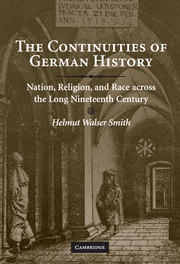Book contents
- Frontmatter
- Contents
- Introduction
- 1 The Vanishing Point of German History
- 2 The Mirror Turn Lamp: Senses of the Nation before Nationalism
- 3 On Catastrophic Religious Violence and National Belonging: The Thirty Years War and the Massacre of Jews in Social Memory
- 4 From Play to Act: Anti-Jewish Violence in German and European History during the Long Nineteenth Century
- 5 Eliminationist Racism
- Conclusion: Continuities in German History
- Acknowledgments
- Index
3 - On Catastrophic Religious Violence and National Belonging: The Thirty Years War and the Massacre of Jews in Social Memory
Published online by Cambridge University Press: 05 June 2012
- Frontmatter
- Contents
- Introduction
- 1 The Vanishing Point of German History
- 2 The Mirror Turn Lamp: Senses of the Nation before Nationalism
- 3 On Catastrophic Religious Violence and National Belonging: The Thirty Years War and the Massacre of Jews in Social Memory
- 4 From Play to Act: Anti-Jewish Violence in German and European History during the Long Nineteenth Century
- 5 Eliminationist Racism
- Conclusion: Continuities in German History
- Acknowledgments
- Index
Summary
Entire, more than entire have we been devastated!
The maddened clarion, the bold invaders' horde.
The mortar thunder-voiced, the blood-anointed sword
Have all men's sweat and work and store annihilated.
Andreas Gryphius, 1636The hypocritical new love for the Christian religion – God forgive me my sin! – for the Middle Ages, with their art, poetry and faith, stirs up the people to the only atrocity in which it remembers its old liberties – attacking the Jews.
Rahel Levin Varnhagen, 1819Individual will, rather than the seemingly hard facts of race or language or natural borders, makes a nation – this was the message Ernest Renan offered in 1882 in his famous address to the Sorbonne, “Qu'est-ce que'une nation?” A nation is a daily plebiscite, he memorably told his audience. He also reminded them that for a nation to be a nation, it must have a common past of “endeavors, sacrifice, and devotion.” Suffering more than joy unites a people; collective grief is more valuable than a string of triumphs. Yet just as this common past must be remembered, it must also be forgotten. Thanks to a greater scholarly sensitivity to the problems of memory, Renan has recently achieved renewed importance. Yet the kind of memory and forgetting to which Renan referred was very specific; it involved traumatic religious violence: the St. Bartholomew's Massacre of 1581 and the thirteenth-century massacres of the Albigensians in the Midi.
- Type
- Chapter
- Information
- The Continuities of German HistoryNation, Religion, and Race across the Long Nineteenth Century, pp. 74 - 114Publisher: Cambridge University PressPrint publication year: 2008

